 One of the Inca mummies discovered in a mausoleum on a remote cliff face south of Kuelap.(Supplied: Krista Eleftheriou )Help keep family & friends informed by sharing this articleabc.net.au/news/mummys-been-the-word-for-1300-years-perus-kuelap-is-machu-picchu/6793076Link copied
One of the Inca mummies discovered in a mausoleum on a remote cliff face south of Kuelap.(Supplied: Krista Eleftheriou )Help keep family & friends informed by sharing this articleabc.net.au/news/mummys-been-the-word-for-1300-years-perus-kuelap-is-machu-picchu/6793076Link copied
A remote northern Peruvian region famed for its Inca mummies and home to one of South America’s most important ancient cities is on a fast track to becoming a tourism hot spot.
The mummies — Peru’s largest undisturbed collection of the preserved bodies of the Inca civilisation’s elite — were discovered in 1997 south of the walled city of Kuelap in the Laguna de Los Condores area.
Laguna de los Condores has allowed us to look at the other side of the moon, archaeologically speaking, but very few studies have been developed so far
Now Peru’s first cable car will be built and the local airport upgraded for commercial flights to improve access to the region.
The Peruvian government is hoping the project will help the 1,300-year-old city, in the Andean Amazon region of Chachapoya, become the Machu Picchu of northern Peru — attracting as many tourists as the world famous southern Inca landmark.
The steep mountains and dramatic cliffs across the Chachapoya region are littered with ruins, elaborate burial sites, mummies, sarcophagi and other artefacts left behind by the Chachapoya and Inca people.
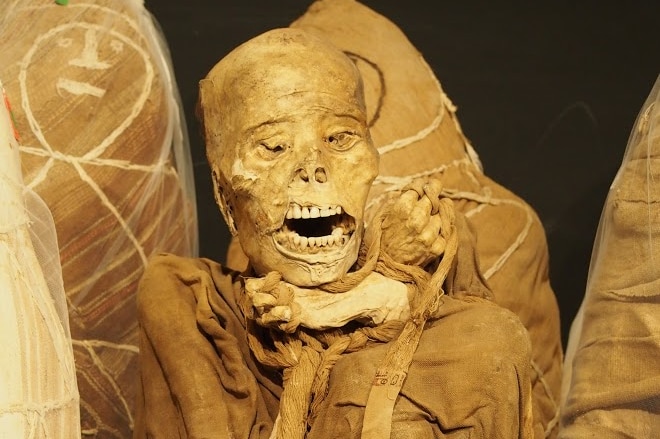 Another of the Inca mummies found near Kuelap(Supplied: Krista Eleftheriou)
Another of the Inca mummies found near Kuelap(Supplied: Krista Eleftheriou)
“Approximately 90 per cent of Chachapoyan archaeology is undiscovered,” says Peter Lerche, a historian and former mayor of the provincial capital Chachapoyas.
“Every week you could have a new story about a newly discovered site.”
 Anthropologist Dr Sonia Guillen is Peru’s leading expert on mummies(Supplied: Krista Eleftheriou)
Anthropologist Dr Sonia Guillen is Peru’s leading expert on mummies(Supplied: Krista Eleftheriou)
Bio-anthropologist Dr Sonia Guillen, who is Peru’s leading expert on mummies, says the significance of the region should not be underestimated.
“Laguna de Los Condores has allowed us to look at the other side of the moon, archaeologically speaking,” Dr Guillen says.
“It has allowed us to look into organic human remains while in the past we could only look at architecture, pottery and the few elements that had survived.
“Suddenly, not only did we look at skeletons, but we had mummies where we looked at their organs and we could trace diseases.”
Dr Guillen and her team documented the collection on location, but were forced to remove the mummies after many were damaged and looted.
The stolen mummies were recovered a year later.
The 219 mummies are now conserved in Leymebamba Museum, south of Kuelap, as part of a project funded by the British Museum.
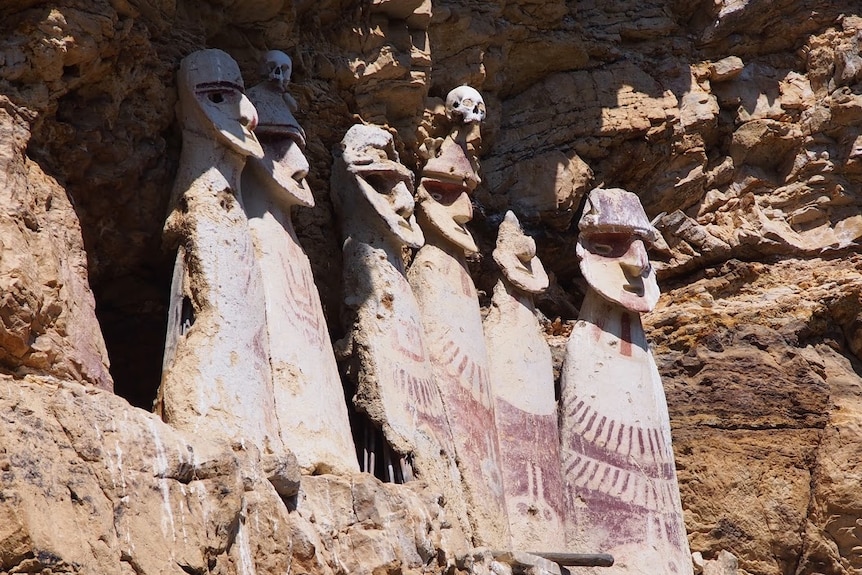 Sarcophagi at Karajia — the Chachapoya, and later the Inca, often buried their dead in sarcophagi in caves on steep cliffs.(Supplied: Krista Eleftheriou)
Sarcophagi at Karajia — the Chachapoya, and later the Inca, often buried their dead in sarcophagi in caves on steep cliffs.(Supplied: Krista Eleftheriou)
Skeletons discovered in walls and foundations
The dead were very important to both the Inca and Chachapoya people, something that is evident in the fortified city of Kuelap.
Kuelap and the Chachapoya people
- Built and occupied between 700AD and 1470AD.
- Includes 12 sites and 400 circular buildings that once housed up to 3,000 people.
- Some walls are 20 metres high and the foundations of the houses contain skeletons.
- Archaeologists found evidence of scalping, the only example in Latin America.
- For 60 years, the Incas tried to control the Chachapoya and their important east-west trading route.
- Many Chachpaoya chiefdoms fought alongside the Spanish conquistadors to help defeat the Incas.
- Colonial disease decimated the Chachapoya, with the population falling from an estimated 500,000 to just 10,000 by 1750.
To date more than 100 skeletons have been found in the 20-metre high perimeter walls and the foundations of homes.
The burial tradition was replaced by the mummification of the dead by the invading Inca.
The city is 700 years older than the Inca site of Machu Picchu and was built on a mountain top, 3,000 metres above sea level, by the Chachapoya around 800AD.
Construction continued until the arrival of the Incas around 1470AD.
“They (the Chachapoya) were exceptional warriors who were headhunters and eventually scalpers too, shamans, farmers, traders, architects, climbers and cavers,” Mr Lerche says.
Archaeologists have called Kuelap the pre-Columbian Vatican, and believe it was a political and religious centre of the Chachapoya people, who built hundreds of kilometres of tracks for their trade between the Amazon, the Andes and the Pacific.
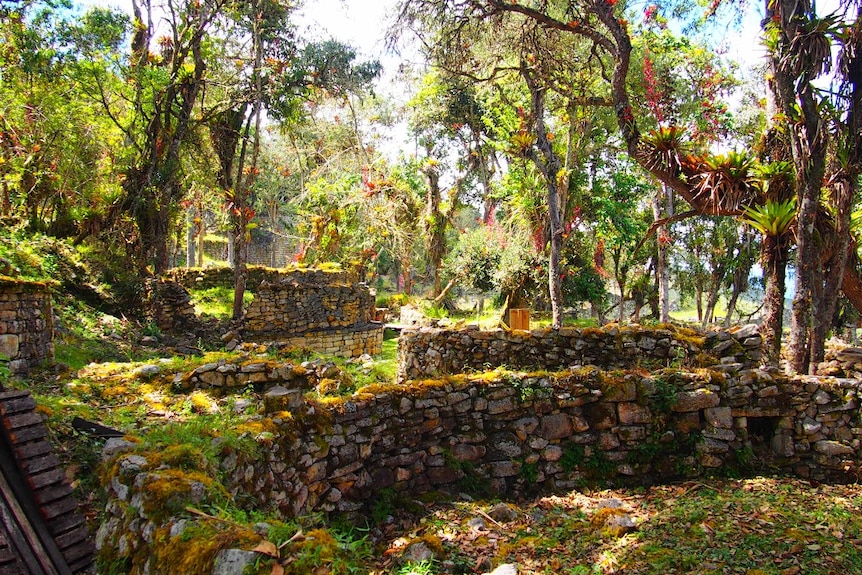 The foundations of more than 400 round houses have been uncovered at Kuelap, with skeletons buried in the foundations.(Supplied: Krista Eleftheriou)
The foundations of more than 400 round houses have been uncovered at Kuelap, with skeletons buried in the foundations.(Supplied: Krista Eleftheriou)
‘The cable car is coming’: airport upgrade and foreign business
Until now, the ancient city’s remote location has prevented large numbers of tourists from visiting the ruins.
But the $US21 million cable car and airport overhaul, allowing commercial flights within a year, will place Kuelap within three hours travel time of the capital Lima, instead of the current 12 hours.
“Thirty thousand people visited Kuelap last year, that number will double in the first year of the cable car opening,” Association of Travel Agencies president Carlo Magno Galoc says.
In the provincial capital, Chachapoyas, the community is preparing for the influx.
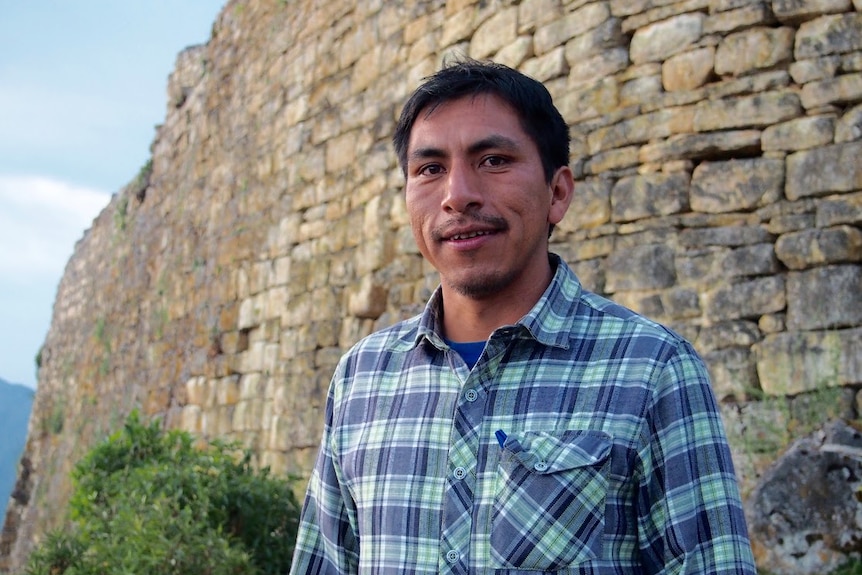 Carlo Magno Galoc at the Kuelap ruins(Supplied: Krista Eleftheriou)
Carlo Magno Galoc at the Kuelap ruins(Supplied: Krista Eleftheriou)
“Chachapoyas will change completely,” Mr Galoc predicts.
“Many people are coming to open new businesses, and international businesses are coming in too. Many people are buying land because the tourism is growing.”
Along the mountain track that leads to Kuelap is the small village of New Tinga where tourists will board the cable car.
Hotel owner Miriam Cauenero Mori believes the project will bring huge economic benefits to the small community.
“Now, most tourists pass us by, but I am building to expand the hotel because the cable car is coming and will bring more people asking for accommodation,” she says.
Work commenced on the cable car last month, but Mr Lerche says the money should have been invested in conserving Kuelap.
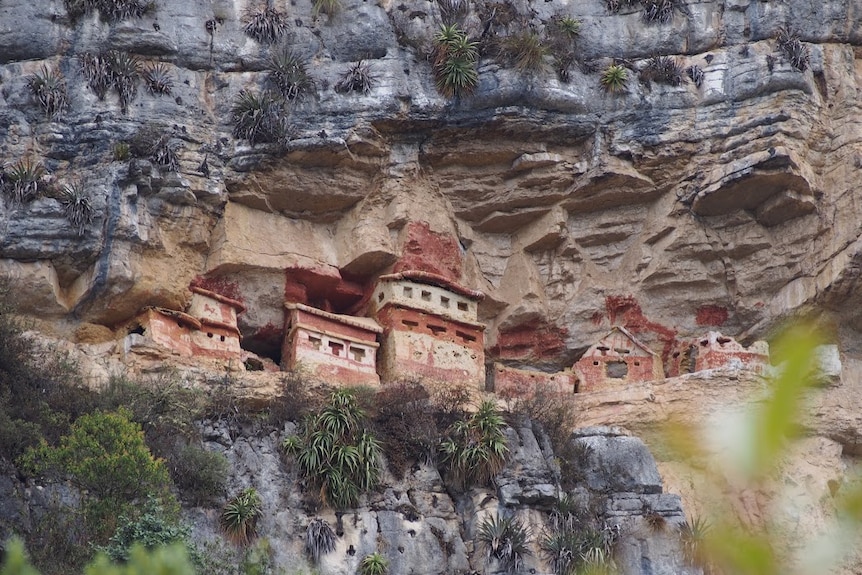 Revash, south of Kuelap, was built to house the Chachapoya dead — the remote Peruvian region has many similar burial sites.(Supplied: Krista Eleftheriou )
Revash, south of Kuelap, was built to house the Chachapoya dead — the remote Peruvian region has many similar burial sites.(Supplied: Krista Eleftheriou )
“Some sectors are in emergency,” he says.
“There are no plans to invest in the excavation, restoration or consolidation of Kuelap, which was maybe 5 per cent excavated.”
Dr Guillen is hoping the increase in tourism will boost funding for archaeological research and conservation for the mummies and a new site discovered four years ago.
The site has already been damaged and looted.
“We are interested in a very exciting site, discovered in 2011, that is filled with sarcophagi,” she says.
“We have been trying to bring funding and commitment to do the archaeology work.
“If more tourists come, we will have more funds. We would be able to focus on research, not just our survival.”
 A reconstructed Chachapoyan house at the Kuelap archaeological site.(Supplied: Krista Eleftheriou)
A reconstructed Chachapoyan house at the Kuelap archaeological site.(Supplied: Krista Eleftheriou)





